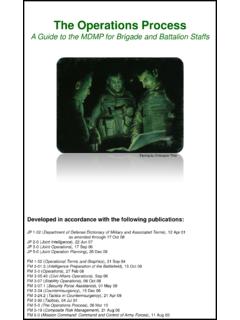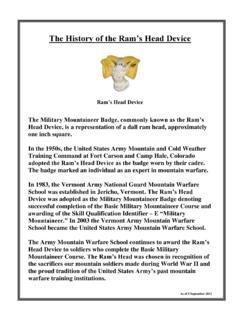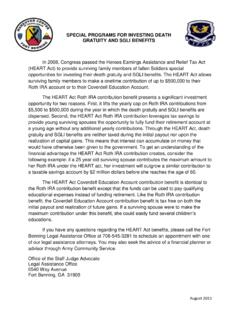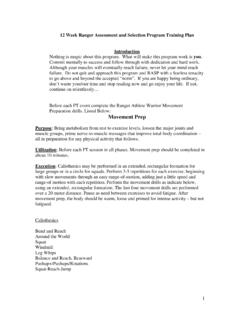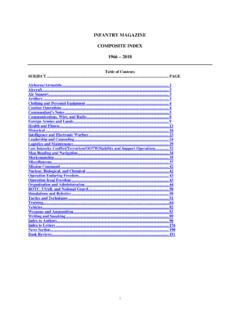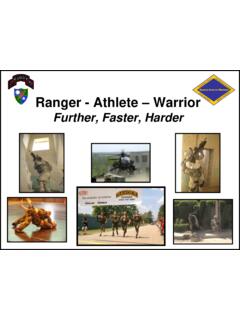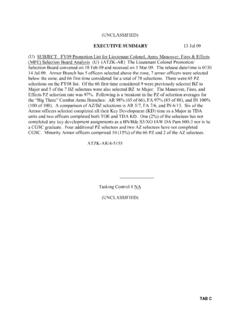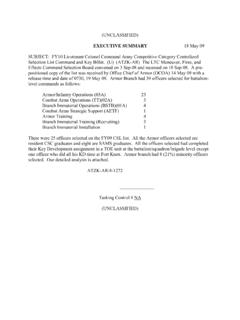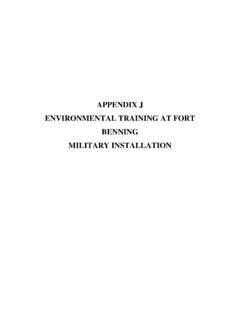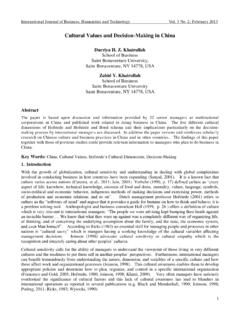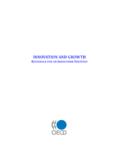Transcription of DISTRIBUTION RESTRICTION: TRADOC -Intelligence Support ...
1 ST 7-100. Version OPFOR. Battle Book for the Operational Environment June 2013. Army TRADOC G-2. TRADOC -Intelligence Support Activity (TRISA) Threats Complex Operational Environment and Threat Integration Directorate (CTID). Fort Leavenworth, Kansas DISTRIBUTION RESTRICTION: Approved for public release; DISTRIBUTION is unlimited. INTRODUCTION. OPERATIONAL ENVIRONMENT (OE). Opposing Force (OPFOR) doctrine is the fighting method used by the Combat Training Centers (CTC) and other training OPFORs. It is to be a composite model of the strategic environment based on existing and projected threats (named hybrid threat ), artificial training, and notional training.
2 This doctrine provides for OPFOR organizations and fighting methods across the spectrum of potential training scenarios, objectives and BLUE force mixes. Doctrinal tenets of the OE focus on the reasoning behind the use of particular tactics, techniques and procedures (TTP) and do not prescribe specific battlefield geometries, formations or time schedules. The doctrine is a composite of real world models, taking its basis in reality, but keying on the focus to challenge task execution. Old Soviet doctrine concepts were removed. However, if a concept remained sound and is in use by potential adversaries of the , it will appear in the doctrine under another name.
3 Army Regulation (AR) 350-2, Opposing Force (OPFOR). Program, dated 09 April 2004 specifically prohibits the use of real-world countries in an unclassified training environment. Joint Publication 3-0 defines operational environment as a composite of the conditions, circumstances, and influences that affect the employment of capabilities and bear on the decisions of commanders. This environment includes land, maritime, space and associated threats presence, as well as friendly and neutral systems. The Decisive Action Training Environment (DATE) document was developed to provide the Army training community with a detailed description of the conditions of five OEs in the Caucasus region; specifically the countries of Ariana, Atropia, Gorgas, Minaria, and Donovia.
4 It presents trainers with a tool to assist in the construction of scenarios for specific training events but does not provide a complete scenario. The DATE offers discussions of OE conditions through the Political, Military, Economic, Social, Information, Infrastructure, Physical Environment, and Time (PMESII-PT) variables. COMPLEX OPFOR / HYBRID THREAT. In training for the realities of the OE, the Army needs a different type of OPFOR than that of the 1970s, 80s, and 90s which incorporates the hard lessons learned in Afghanistan, Iraq, and the Philippines.
5 The Training Circular (TC). TC 7-100 series defines this complex OPFOR as a plausible, flexible military and/or paramilitary force representing a composite of varying capabilities of actual worldwide forces, used in lieu of a specific threat force, for training and developing forces. In the training environment, the OPFOR is a training tool that represents the nature and capabilities of various kinds of forces the Army might face in the OE. This Student Text is not comprehensive concerning the OE or the OPFOR. You can download complete information in the following regulations, manuals, circulars, and documents the Army Training Network (ATN) at OPFOR RESOURCES.
6 (Current and future). AR 350-2, OPFOR Program, 09 APR 2004. TC 7-100, Hybrid Threats, November 2010. FM , Opposing Forces Operations, 27 Dec 2004 (to be re-written as a TC). TC , Opposing Forces Tactics (Approved final draft, August 2011). TC , Irregular Opposing Forces (to be published). FM , Opposing Forces Organization Guide, 03 May 2007(to be re-written as a TC). TC 7-101, Exercise Design, November 2010. TC 7-102, Operational Considerations for Training and Education Development, Approved Final Draft June 2013. Worldwide Equipment Guide (WEG), September 2012.
7 Decisive Action Training Environment (DATE) version 2, December 2011. PREFACE. ST 7-100 OPFOR Battle Book for the Operational Environment is a reference guide prepared under the direction of the Army Training and Doctrine Command, Intelligence Support Activity (TRISA) - Complex OE & Threat Integration Directorate (CTID). This student text, using the PMESII-PT variables of the OE, outlines a methodology for integrating the OPFOR into training exercises. This student text replaces ST 7-100 dated June 2005. Purpose. To provide an overview of the OE Estimate, the eight OE variables, Hybrid threats, Decisive Action Training Environment (DATE), OE assessments, the OPFOR organization guide, tactical level OPFOR tactics, and the Worldwide Equipment Guide (WEG).
8 It supports operational missions, institutional training, and professional military education for military forces. This student text is a supplement to the 7-100 series of OPFOR. documents and is not a replacement document. Intended Audience. This student text exists primarily for military students. Compiled from open source material, this student text promotes an OPFOR perspective in a composite-model training environment and is not a replacement document. Using ST 7-100. Study and integration of the OPFOR in the OE improves the readiness of military forces.
9 As a living document, TRISA updates this student text as necessary to ensure it remains a current and relevant resource. Each of the student text chapters contains specific information designed to assist the student in developing a realistic and challenging OPFOR. Links within the student text provide expanded information and ease of use. Unless stated otherwise, masculine nouns and pronouns do not refer exclusively to the male gender. Proponent Statement. Headquarters, Army Training and Doctrine Command ( TRADOC ) is the proponent for this publication. Periodic updates will accommodate emergent user requirements.
10 Send comments and recommendations on DA Form 2028 directly to TRADOC TRISA-Threats at the following address: TRADOC . TRISA-Threats, ATTN: ATIN-T, 803 Harrison, Drive, Bldg 467, Fort Leavenworth, Kansas 66027-1323. 2. TABLE OF CONTENTS: Chapter 1. The OE Estimate 5. Chapter 2. Political, Military, Economic, Social, Information, Infrastructure, 6. Physical Environment, and Time (PMESII-PT) variables Chapter 3. Hybrid Threats and the Decisive Action Training Environment (DATE) .10. Chapter 4. OPFOR Organization Guide ..15. Chapter 5. OPFOR Task Organization for Combat.
